E1144 CHC33015 Individual Support: Dementia Communication Strategies
VerifiedAdded on 2023/06/18
|25
|9077
|270
Homework Assignment
AI Summary
This assignment focuses on effective communication strategies for supporting individuals living with dementia within an aged care setting. It addresses verbal and non-verbal techniques to ensure effective communication, person-centered approaches to care, and activities that maintain dignity, skills, and health. The assignment includes scenarios requiring the application of these strategies, such as assisting Kostas with daily activities and advising Anna on how to improve her communication with him. It also covers identifying and responding to changes in client behaviors, evaluating strategies to minimize behavioral effects, and emphasizing the importance of self-care for care support workers and their families. The solutions provided demonstrate practical application of communication techniques like eye contact, reminders, direct statements, touch, simple questions, reality orientation, and tone of voice reassurance to improve care quality and reduce patient agitation. Desklib offers a wealth of solved assignments and study resources for students.
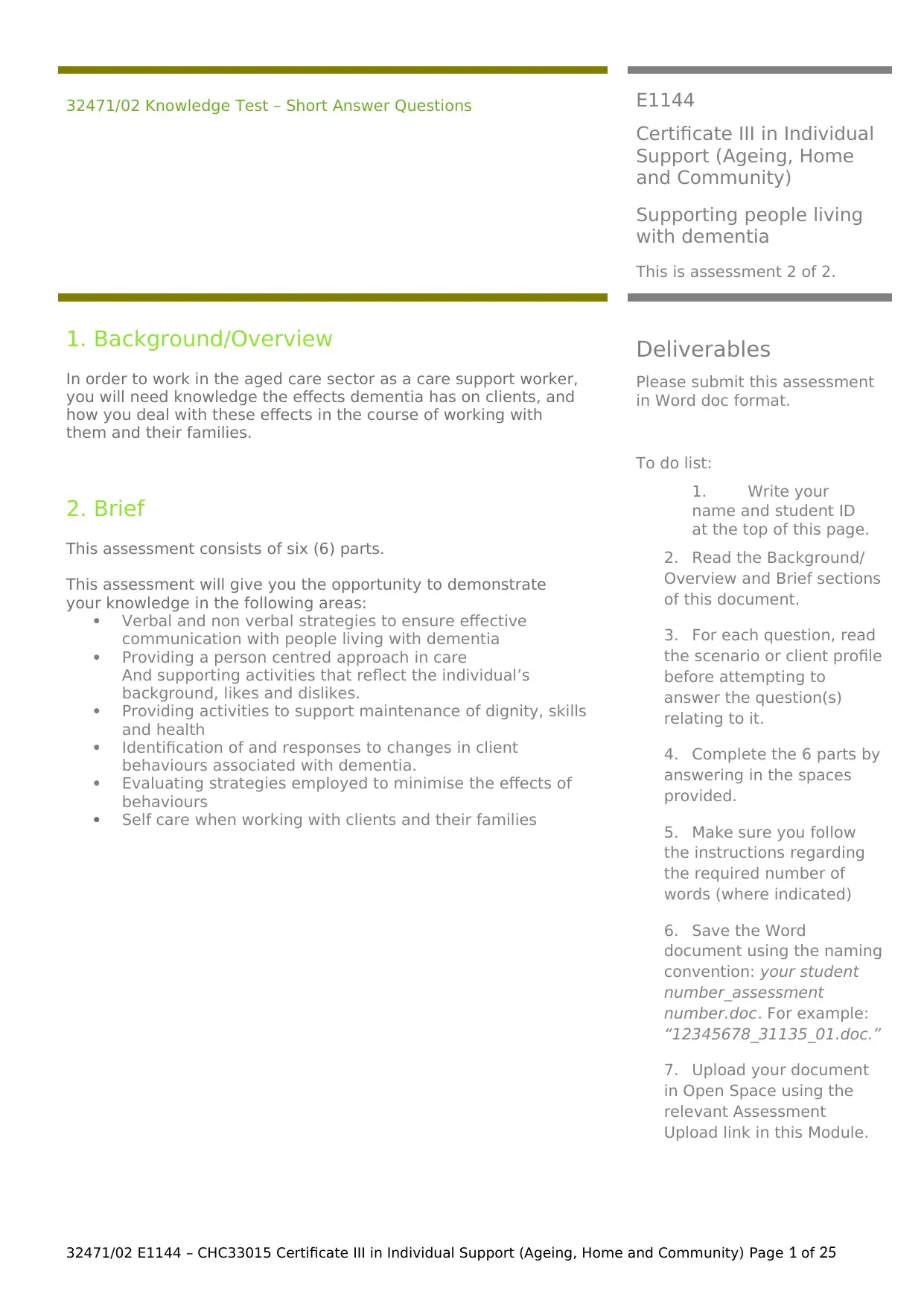
32471/02 Knowledge Test – Short Answer Questions E1144
Certificate III in Individual
Support (Ageing, Home
and Community)
Supporting people living
with dementia
This is assessment 2 of 2.
1. Background/Overview
In order to work in the aged care sector as a care support worker,
you will need knowledge the effects dementia has on clients, and
how you deal with these effects in the course of working with
them and their families.
2. Brief
This assessment consists of six (6) parts.
This assessment will give you the opportunity to demonstrate
your knowledge in the following areas:
Verbal and non verbal strategies to ensure effective
communication with people living with dementia
Providing a person centred approach in care
And supporting activities that reflect the individual’s
background, likes and dislikes.
Providing activities to support maintenance of dignity, skills
and health
Identification of and responses to changes in client
behaviours associated with dementia.
Evaluating strategies employed to minimise the effects of
behaviours
Self care when working with clients and their families
Deliverables
Please submit this assessment
in Word doc format.
To do list:
1. Write your
name and student ID
at the top of this page.
2. Read the Background/
Overview and Brief sections
of this document.
3. For each question, read
the scenario or client profile
before attempting to
answer the question(s)
relating to it.
4. Complete the 6 parts by
answering in the spaces
provided.
5. Make sure you follow
the instructions regarding
the required number of
words (where indicated)
6. Save the Word
document using the naming
convention: your student
number_assessment
number.doc. For example:
“12345678_31135_01.doc.”
7. Upload your document
in Open Space using the
relevant Assessment
Upload link in this Module.
32471/02 E1144 – CHC33015 Certificate III in Individual Support (Ageing, Home and Community) Page 1 of 25
Certificate III in Individual
Support (Ageing, Home
and Community)
Supporting people living
with dementia
This is assessment 2 of 2.
1. Background/Overview
In order to work in the aged care sector as a care support worker,
you will need knowledge the effects dementia has on clients, and
how you deal with these effects in the course of working with
them and their families.
2. Brief
This assessment consists of six (6) parts.
This assessment will give you the opportunity to demonstrate
your knowledge in the following areas:
Verbal and non verbal strategies to ensure effective
communication with people living with dementia
Providing a person centred approach in care
And supporting activities that reflect the individual’s
background, likes and dislikes.
Providing activities to support maintenance of dignity, skills
and health
Identification of and responses to changes in client
behaviours associated with dementia.
Evaluating strategies employed to minimise the effects of
behaviours
Self care when working with clients and their families
Deliverables
Please submit this assessment
in Word doc format.
To do list:
1. Write your
name and student ID
at the top of this page.
2. Read the Background/
Overview and Brief sections
of this document.
3. For each question, read
the scenario or client profile
before attempting to
answer the question(s)
relating to it.
4. Complete the 6 parts by
answering in the spaces
provided.
5. Make sure you follow
the instructions regarding
the required number of
words (where indicated)
6. Save the Word
document using the naming
convention: your student
number_assessment
number.doc. For example:
“12345678_31135_01.doc.”
7. Upload your document
in Open Space using the
relevant Assessment
Upload link in this Module.
32471/02 E1144 – CHC33015 Certificate III in Individual Support (Ageing, Home and Community) Page 1 of 25
Paraphrase This Document
Need a fresh take? Get an instant paraphrase of this document with our AI Paraphraser
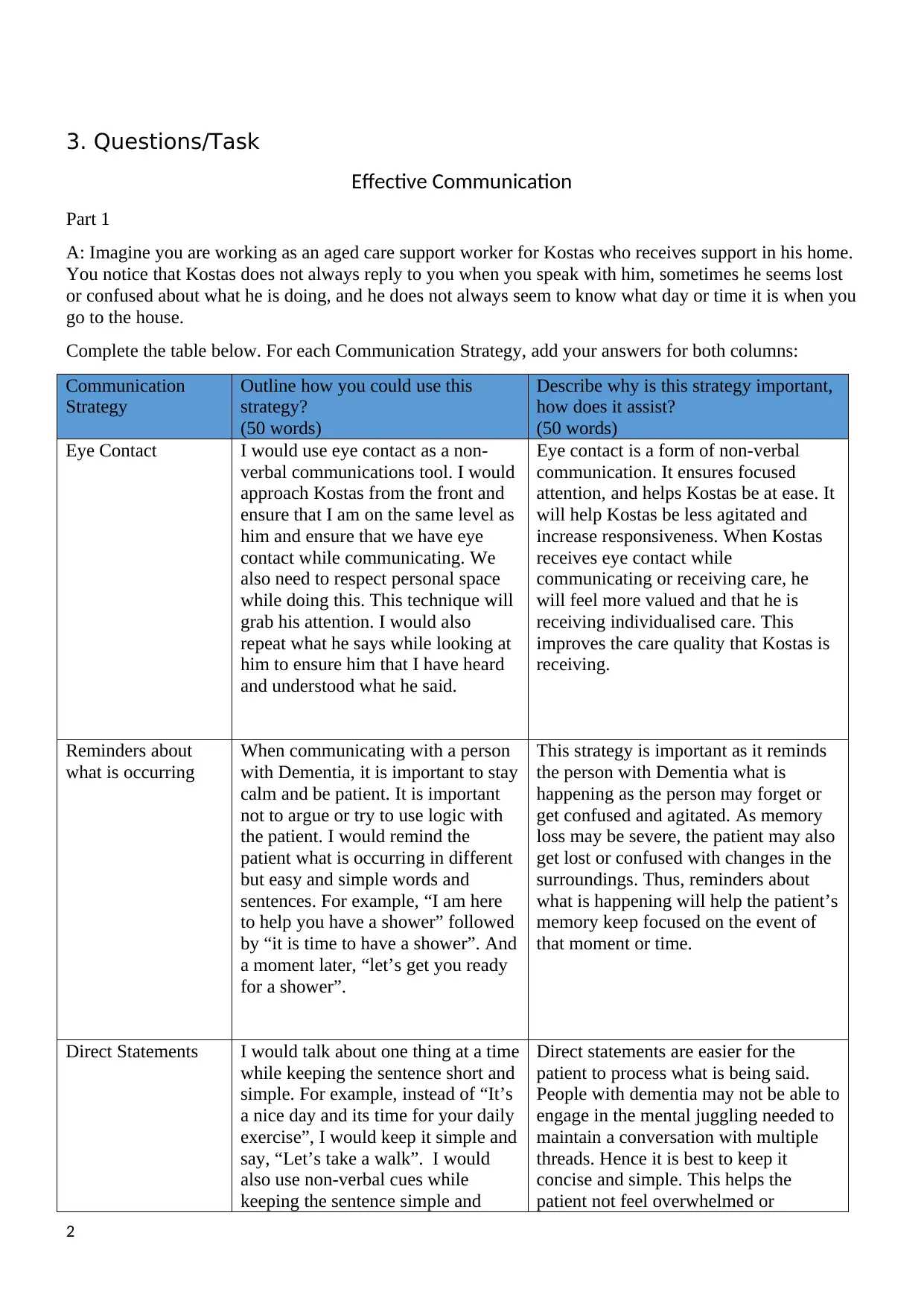
3. Questions/Task
Effective Communication
Part 1
A: Imagine you are working as an aged care support worker for Kostas who receives support in his home.
You notice that Kostas does not always reply to you when you speak with him, sometimes he seems lost
or confused about what he is doing, and he does not always seem to know what day or time it is when you
go to the house.
Complete the table below. For each Communication Strategy, add your answers for both columns:
Communication
Strategy
Outline how you could use this
strategy?
(50 words)
Describe why is this strategy important,
how does it assist?
(50 words)
Eye Contact I would use eye contact as a non-
verbal communications tool. I would
approach Kostas from the front and
ensure that I am on the same level as
him and ensure that we have eye
contact while communicating. We
also need to respect personal space
while doing this. This technique will
grab his attention. I would also
repeat what he says while looking at
him to ensure him that I have heard
and understood what he said.
Eye contact is a form of non-verbal
communication. It ensures focused
attention, and helps Kostas be at ease. It
will help Kostas be less agitated and
increase responsiveness. When Kostas
receives eye contact while
communicating or receiving care, he
will feel more valued and that he is
receiving individualised care. This
improves the care quality that Kostas is
receiving.
Reminders about
what is occurring
When communicating with a person
with Dementia, it is important to stay
calm and be patient. It is important
not to argue or try to use logic with
the patient. I would remind the
patient what is occurring in different
but easy and simple words and
sentences. For example, “I am here
to help you have a shower” followed
by “it is time to have a shower”. And
a moment later, “let’s get you ready
for a shower”.
This strategy is important as it reminds
the person with Dementia what is
happening as the person may forget or
get confused and agitated. As memory
loss may be severe, the patient may also
get lost or confused with changes in the
surroundings. Thus, reminders about
what is happening will help the patient’s
memory keep focused on the event of
that moment or time.
Direct Statements I would talk about one thing at a time
while keeping the sentence short and
simple. For example, instead of “It’s
a nice day and its time for your daily
exercise”, I would keep it simple and
say, “Let’s take a walk”. I would
also use non-verbal cues while
keeping the sentence simple and
Direct statements are easier for the
patient to process what is being said.
People with dementia may not be able to
engage in the mental juggling needed to
maintain a conversation with multiple
threads. Hence it is best to keep it
concise and simple. This helps the
patient not feel overwhelmed or
2
Effective Communication
Part 1
A: Imagine you are working as an aged care support worker for Kostas who receives support in his home.
You notice that Kostas does not always reply to you when you speak with him, sometimes he seems lost
or confused about what he is doing, and he does not always seem to know what day or time it is when you
go to the house.
Complete the table below. For each Communication Strategy, add your answers for both columns:
Communication
Strategy
Outline how you could use this
strategy?
(50 words)
Describe why is this strategy important,
how does it assist?
(50 words)
Eye Contact I would use eye contact as a non-
verbal communications tool. I would
approach Kostas from the front and
ensure that I am on the same level as
him and ensure that we have eye
contact while communicating. We
also need to respect personal space
while doing this. This technique will
grab his attention. I would also
repeat what he says while looking at
him to ensure him that I have heard
and understood what he said.
Eye contact is a form of non-verbal
communication. It ensures focused
attention, and helps Kostas be at ease. It
will help Kostas be less agitated and
increase responsiveness. When Kostas
receives eye contact while
communicating or receiving care, he
will feel more valued and that he is
receiving individualised care. This
improves the care quality that Kostas is
receiving.
Reminders about
what is occurring
When communicating with a person
with Dementia, it is important to stay
calm and be patient. It is important
not to argue or try to use logic with
the patient. I would remind the
patient what is occurring in different
but easy and simple words and
sentences. For example, “I am here
to help you have a shower” followed
by “it is time to have a shower”. And
a moment later, “let’s get you ready
for a shower”.
This strategy is important as it reminds
the person with Dementia what is
happening as the person may forget or
get confused and agitated. As memory
loss may be severe, the patient may also
get lost or confused with changes in the
surroundings. Thus, reminders about
what is happening will help the patient’s
memory keep focused on the event of
that moment or time.
Direct Statements I would talk about one thing at a time
while keeping the sentence short and
simple. For example, instead of “It’s
a nice day and its time for your daily
exercise”, I would keep it simple and
say, “Let’s take a walk”. I would
also use non-verbal cues while
keeping the sentence simple and
Direct statements are easier for the
patient to process what is being said.
People with dementia may not be able to
engage in the mental juggling needed to
maintain a conversation with multiple
threads. Hence it is best to keep it
concise and simple. This helps the
patient not feel overwhelmed or
2
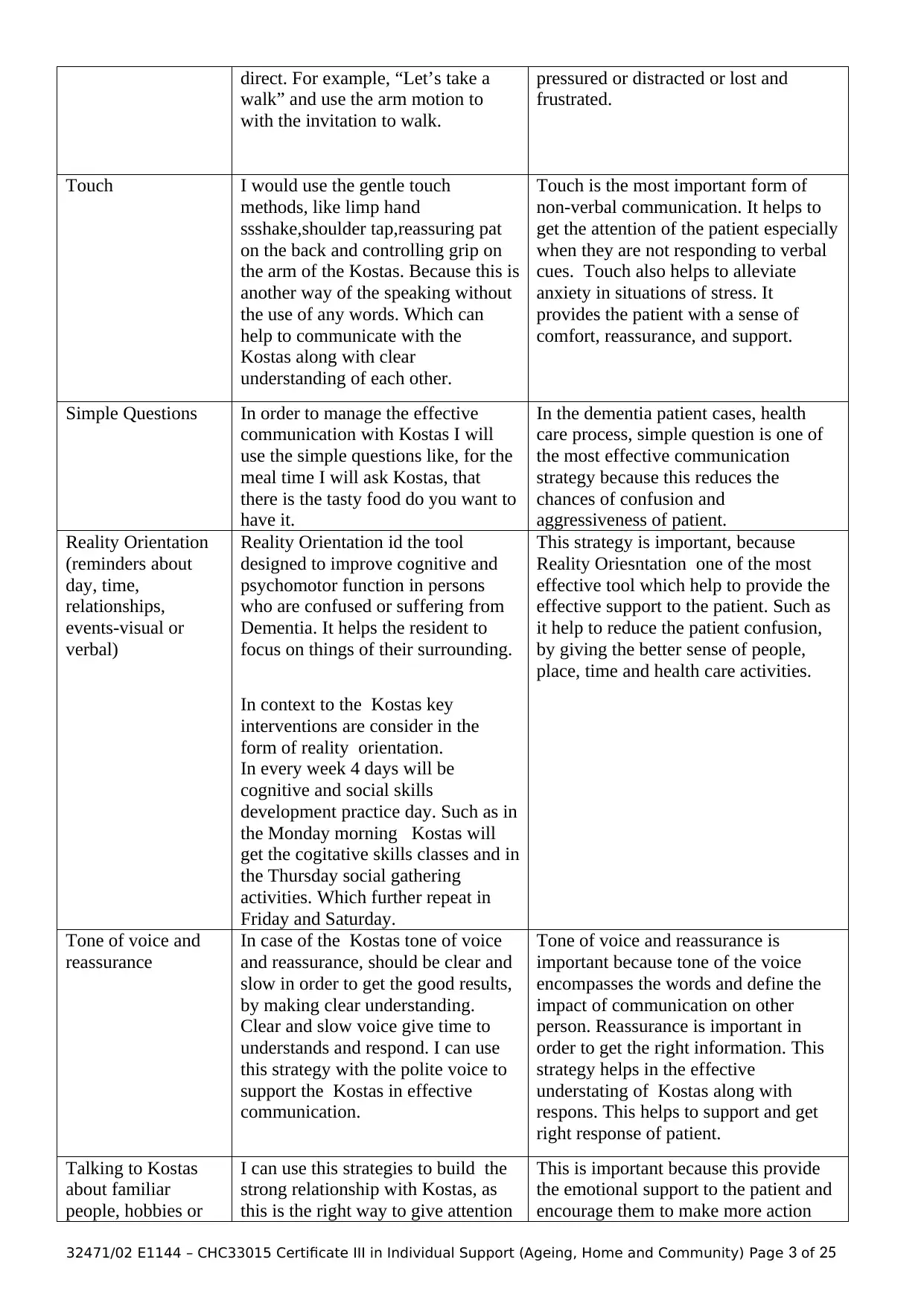
direct. For example, “Let’s take a
walk” and use the arm motion to
with the invitation to walk.
pressured or distracted or lost and
frustrated.
Touch I would use the gentle touch
methods, like limp hand
ssshake,shoulder tap,reassuring pat
on the back and controlling grip on
the arm of the Kostas. Because this is
another way of the speaking without
the use of any words. Which can
help to communicate with the
Kostas along with clear
understanding of each other.
Touch is the most important form of
non-verbal communication. It helps to
get the attention of the patient especially
when they are not responding to verbal
cues. Touch also helps to alleviate
anxiety in situations of stress. It
provides the patient with a sense of
comfort, reassurance, and support.
Simple Questions In order to manage the effective
communication with Kostas I will
use the simple questions like, for the
meal time I will ask Kostas, that
there is the tasty food do you want to
have it.
In the dementia patient cases, health
care process, simple question is one of
the most effective communication
strategy because this reduces the
chances of confusion and
aggressiveness of patient.
Reality Orientation
(reminders about
day, time,
relationships,
events-visual or
verbal)
Reality Orientation id the tool
designed to improve cognitive and
psychomotor function in persons
who are confused or suffering from
Dementia. It helps the resident to
focus on things of their surrounding.
In context to the Kostas key
interventions are consider in the
form of reality orientation.
In every week 4 days will be
cognitive and social skills
development practice day. Such as in
the Monday morning Kostas will
get the cogitative skills classes and in
the Thursday social gathering
activities. Which further repeat in
Friday and Saturday.
This strategy is important, because
Reality Oriesntation one of the most
effective tool which help to provide the
effective support to the patient. Such as
it help to reduce the patient confusion,
by giving the better sense of people,
place, time and health care activities.
Tone of voice and
reassurance
In case of the Kostas tone of voice
and reassurance, should be clear and
slow in order to get the good results,
by making clear understanding.
Clear and slow voice give time to
understands and respond. I can use
this strategy with the polite voice to
support the Kostas in effective
communication.
Tone of voice and reassurance is
important because tone of the voice
encompasses the words and define the
impact of communication on other
person. Reassurance is important in
order to get the right information. This
strategy helps in the effective
understating of Kostas along with
respons. This helps to support and get
right response of patient.
Talking to Kostas
about familiar
people, hobbies or
I can use this strategies to build the
strong relationship with Kostas, as
this is the right way to give attention
This is important because this provide
the emotional support to the patient and
encourage them to make more action
32471/02 E1144 – CHC33015 Certificate III in Individual Support (Ageing, Home and Community) Page 3 of 25
walk” and use the arm motion to
with the invitation to walk.
pressured or distracted or lost and
frustrated.
Touch I would use the gentle touch
methods, like limp hand
ssshake,shoulder tap,reassuring pat
on the back and controlling grip on
the arm of the Kostas. Because this is
another way of the speaking without
the use of any words. Which can
help to communicate with the
Kostas along with clear
understanding of each other.
Touch is the most important form of
non-verbal communication. It helps to
get the attention of the patient especially
when they are not responding to verbal
cues. Touch also helps to alleviate
anxiety in situations of stress. It
provides the patient with a sense of
comfort, reassurance, and support.
Simple Questions In order to manage the effective
communication with Kostas I will
use the simple questions like, for the
meal time I will ask Kostas, that
there is the tasty food do you want to
have it.
In the dementia patient cases, health
care process, simple question is one of
the most effective communication
strategy because this reduces the
chances of confusion and
aggressiveness of patient.
Reality Orientation
(reminders about
day, time,
relationships,
events-visual or
verbal)
Reality Orientation id the tool
designed to improve cognitive and
psychomotor function in persons
who are confused or suffering from
Dementia. It helps the resident to
focus on things of their surrounding.
In context to the Kostas key
interventions are consider in the
form of reality orientation.
In every week 4 days will be
cognitive and social skills
development practice day. Such as in
the Monday morning Kostas will
get the cogitative skills classes and in
the Thursday social gathering
activities. Which further repeat in
Friday and Saturday.
This strategy is important, because
Reality Oriesntation one of the most
effective tool which help to provide the
effective support to the patient. Such as
it help to reduce the patient confusion,
by giving the better sense of people,
place, time and health care activities.
Tone of voice and
reassurance
In case of the Kostas tone of voice
and reassurance, should be clear and
slow in order to get the good results,
by making clear understanding.
Clear and slow voice give time to
understands and respond. I can use
this strategy with the polite voice to
support the Kostas in effective
communication.
Tone of voice and reassurance is
important because tone of the voice
encompasses the words and define the
impact of communication on other
person. Reassurance is important in
order to get the right information. This
strategy helps in the effective
understating of Kostas along with
respons. This helps to support and get
right response of patient.
Talking to Kostas
about familiar
people, hobbies or
I can use this strategies to build the
strong relationship with Kostas, as
this is the right way to give attention
This is important because this provide
the emotional support to the patient and
encourage them to make more action
32471/02 E1144 – CHC33015 Certificate III in Individual Support (Ageing, Home and Community) Page 3 of 25
⊘ This is a preview!⊘
Do you want full access?
Subscribe today to unlock all pages.

Trusted by 1+ million students worldwide

past occupations. to the patient interact them in
conversation, in order to improve
their condition. I will ask the patient
about hobby, such I will ask the
patient that what is your hobbies,
which you want to involve in your
care plan. Then give higher attention
to the patient answer.
and get well. This helps in the effective
communication by increasing the
interaction and relationship with the
patient. This increase the interest of
patient in care plan.
4
conversation, in order to improve
their condition. I will ask the patient
about hobby, such I will ask the
patient that what is your hobbies,
which you want to involve in your
care plan. Then give higher attention
to the patient answer.
and get well. This helps in the effective
communication by increasing the
interaction and relationship with the
patient. This increase the interest of
patient in care plan.
4
Paraphrase This Document
Need a fresh take? Get an instant paraphrase of this document with our AI Paraphraser
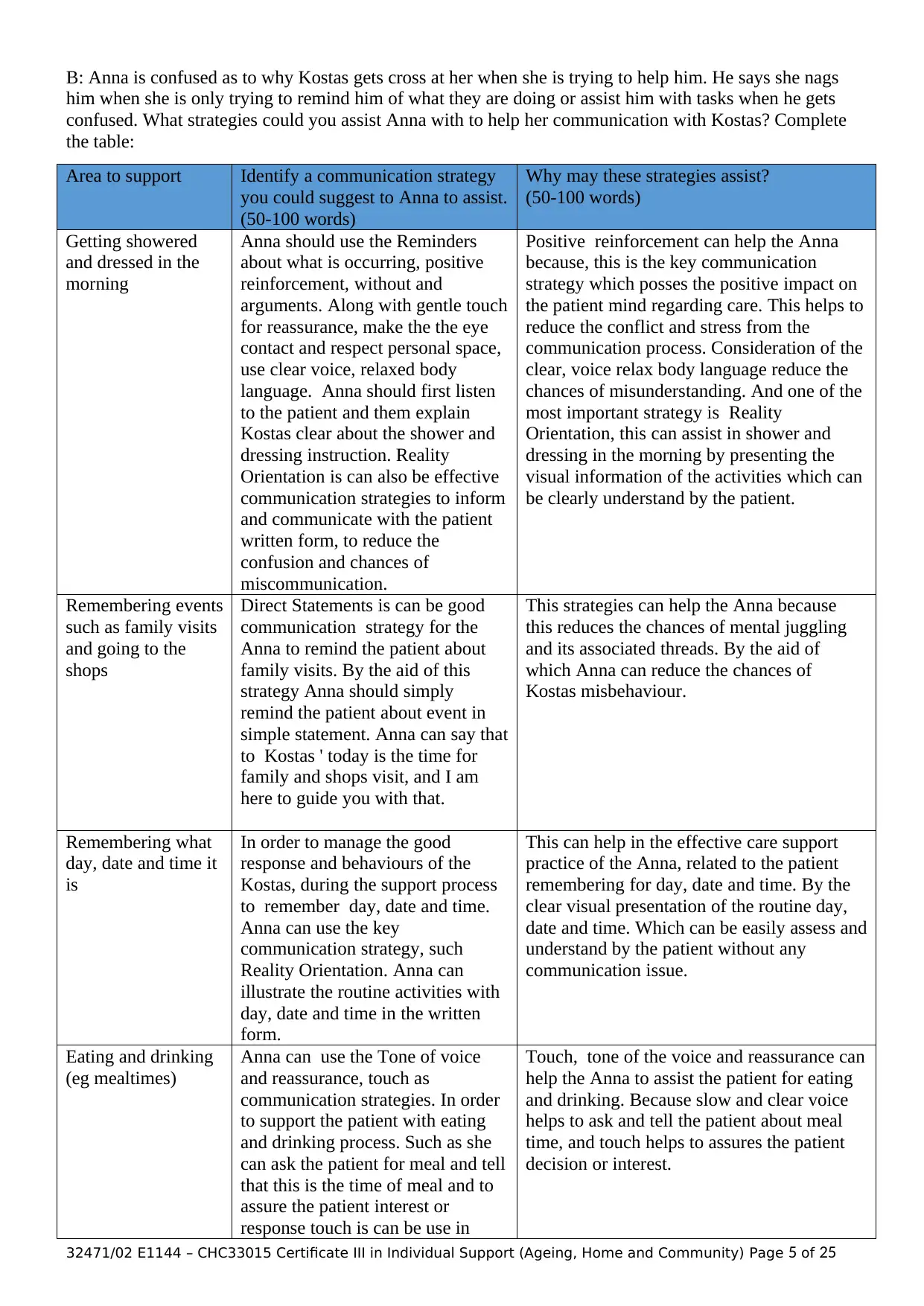
B: Anna is confused as to why Kostas gets cross at her when she is trying to help him. He says she nags
him when she is only trying to remind him of what they are doing or assist him with tasks when he gets
confused. What strategies could you assist Anna with to help her communication with Kostas? Complete
the table:
Area to support Identify a communication strategy
you could suggest to Anna to assist.
(50-100 words)
Why may these strategies assist?
(50-100 words)
Getting showered
and dressed in the
morning
Anna should use the Reminders
about what is occurring, positive
reinforcement, without and
arguments. Along with gentle touch
for reassurance, make the the eye
contact and respect personal space,
use clear voice, relaxed body
language. Anna should first listen
to the patient and them explain
Kostas clear about the shower and
dressing instruction. Reality
Orientation is can also be effective
communication strategies to inform
and communicate with the patient
written form, to reduce the
confusion and chances of
miscommunication.
Positive reinforcement can help the Anna
because, this is the key communication
strategy which posses the positive impact on
the patient mind regarding care. This helps to
reduce the conflict and stress from the
communication process. Consideration of the
clear, voice relax body language reduce the
chances of misunderstanding. And one of the
most important strategy is Reality
Orientation, this can assist in shower and
dressing in the morning by presenting the
visual information of the activities which can
be clearly understand by the patient.
Remembering events
such as family visits
and going to the
shops
Direct Statements is can be good
communication strategy for the
Anna to remind the patient about
family visits. By the aid of this
strategy Anna should simply
remind the patient about event in
simple statement. Anna can say that
to Kostas ' today is the time for
family and shops visit, and I am
here to guide you with that.
This strategies can help the Anna because
this reduces the chances of mental juggling
and its associated threads. By the aid of
which Anna can reduce the chances of
Kostas misbehaviour.
Remembering what
day, date and time it
is
In order to manage the good
response and behaviours of the
Kostas, during the support process
to remember day, date and time.
Anna can use the key
communication strategy, such
Reality Orientation. Anna can
illustrate the routine activities with
day, date and time in the written
form.
This can help in the effective care support
practice of the Anna, related to the patient
remembering for day, date and time. By the
clear visual presentation of the routine day,
date and time. Which can be easily assess and
understand by the patient without any
communication issue.
Eating and drinking
(eg mealtimes)
Anna can use the Tone of voice
and reassurance, touch as
communication strategies. In order
to support the patient with eating
and drinking process. Such as she
can ask the patient for meal and tell
that this is the time of meal and to
assure the patient interest or
response touch is can be use in
Touch, tone of the voice and reassurance can
help the Anna to assist the patient for eating
and drinking. Because slow and clear voice
helps to ask and tell the patient about meal
time, and touch helps to assures the patient
decision or interest.
32471/02 E1144 – CHC33015 Certificate III in Individual Support (Ageing, Home and Community) Page 5 of 25
him when she is only trying to remind him of what they are doing or assist him with tasks when he gets
confused. What strategies could you assist Anna with to help her communication with Kostas? Complete
the table:
Area to support Identify a communication strategy
you could suggest to Anna to assist.
(50-100 words)
Why may these strategies assist?
(50-100 words)
Getting showered
and dressed in the
morning
Anna should use the Reminders
about what is occurring, positive
reinforcement, without and
arguments. Along with gentle touch
for reassurance, make the the eye
contact and respect personal space,
use clear voice, relaxed body
language. Anna should first listen
to the patient and them explain
Kostas clear about the shower and
dressing instruction. Reality
Orientation is can also be effective
communication strategies to inform
and communicate with the patient
written form, to reduce the
confusion and chances of
miscommunication.
Positive reinforcement can help the Anna
because, this is the key communication
strategy which posses the positive impact on
the patient mind regarding care. This helps to
reduce the conflict and stress from the
communication process. Consideration of the
clear, voice relax body language reduce the
chances of misunderstanding. And one of the
most important strategy is Reality
Orientation, this can assist in shower and
dressing in the morning by presenting the
visual information of the activities which can
be clearly understand by the patient.
Remembering events
such as family visits
and going to the
shops
Direct Statements is can be good
communication strategy for the
Anna to remind the patient about
family visits. By the aid of this
strategy Anna should simply
remind the patient about event in
simple statement. Anna can say that
to Kostas ' today is the time for
family and shops visit, and I am
here to guide you with that.
This strategies can help the Anna because
this reduces the chances of mental juggling
and its associated threads. By the aid of
which Anna can reduce the chances of
Kostas misbehaviour.
Remembering what
day, date and time it
is
In order to manage the good
response and behaviours of the
Kostas, during the support process
to remember day, date and time.
Anna can use the key
communication strategy, such
Reality Orientation. Anna can
illustrate the routine activities with
day, date and time in the written
form.
This can help in the effective care support
practice of the Anna, related to the patient
remembering for day, date and time. By the
clear visual presentation of the routine day,
date and time. Which can be easily assess and
understand by the patient without any
communication issue.
Eating and drinking
(eg mealtimes)
Anna can use the Tone of voice
and reassurance, touch as
communication strategies. In order
to support the patient with eating
and drinking process. Such as she
can ask the patient for meal and tell
that this is the time of meal and to
assure the patient interest or
response touch is can be use in
Touch, tone of the voice and reassurance can
help the Anna to assist the patient for eating
and drinking. Because slow and clear voice
helps to ask and tell the patient about meal
time, and touch helps to assures the patient
decision or interest.
32471/02 E1144 – CHC33015 Certificate III in Individual Support (Ageing, Home and Community) Page 5 of 25

gentle form. Anna can tap to the
patient shoulder to seek attention
for conversation and confirmation.
6
patient shoulder to seek attention
for conversation and confirmation.
6
⊘ This is a preview!⊘
Do you want full access?
Subscribe today to unlock all pages.

Trusted by 1+ million students worldwide
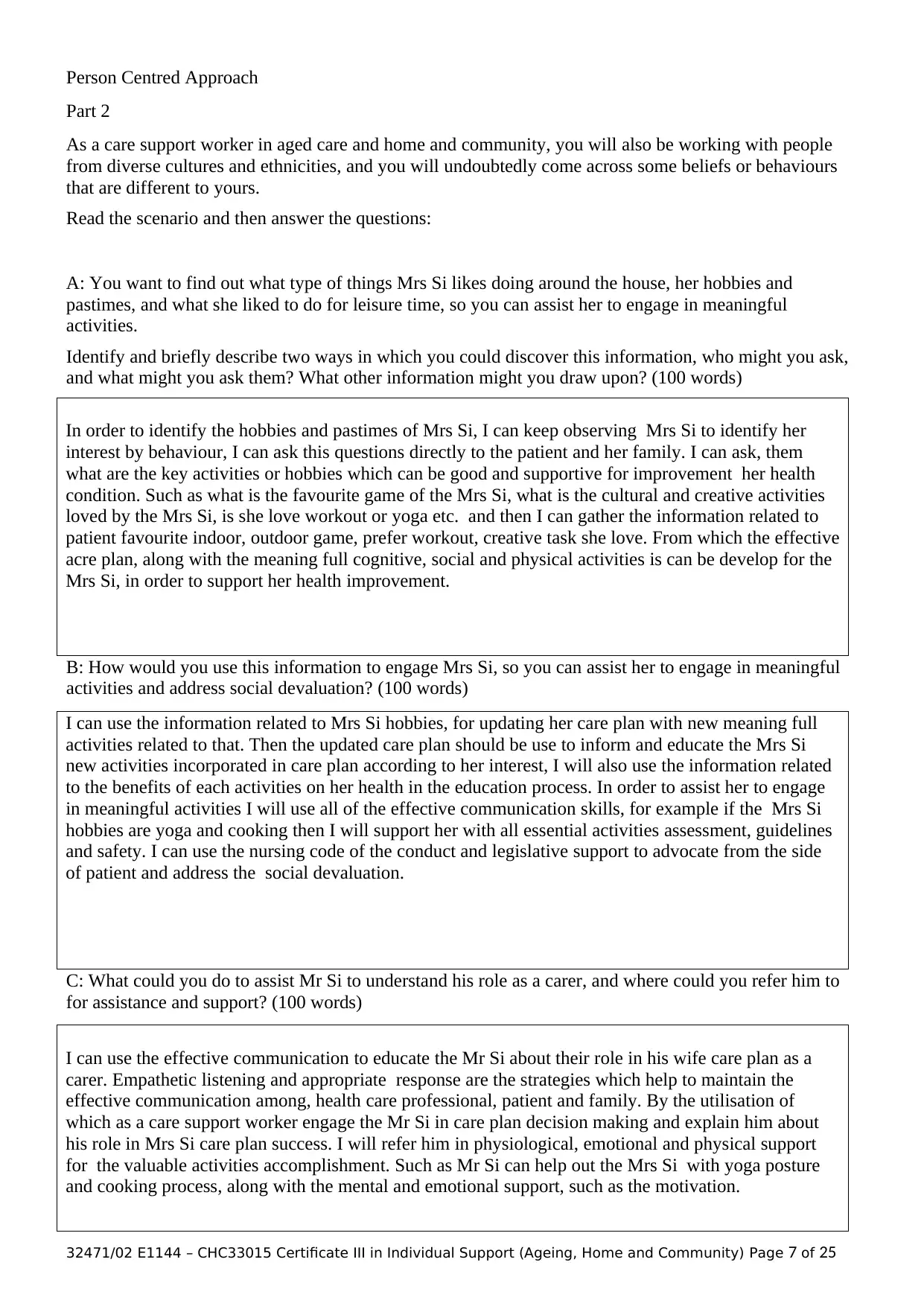
Person Centred Approach
Part 2
As a care support worker in aged care and home and community, you will also be working with people
from diverse cultures and ethnicities, and you will undoubtedly come across some beliefs or behaviours
that are different to yours.
Read the scenario and then answer the questions:
A: You want to find out what type of things Mrs Si likes doing around the house, her hobbies and
pastimes, and what she liked to do for leisure time, so you can assist her to engage in meaningful
activities.
Identify and briefly describe two ways in which you could discover this information, who might you ask,
and what might you ask them? What other information might you draw upon? (100 words)
In order to identify the hobbies and pastimes of Mrs Si, I can keep observing Mrs Si to identify her
interest by behaviour, I can ask this questions directly to the patient and her family. I can ask, them
what are the key activities or hobbies which can be good and supportive for improvement her health
condition. Such as what is the favourite game of the Mrs Si, what is the cultural and creative activities
loved by the Mrs Si, is she love workout or yoga etc. and then I can gather the information related to
patient favourite indoor, outdoor game, prefer workout, creative task she love. From which the effective
acre plan, along with the meaning full cognitive, social and physical activities is can be develop for the
Mrs Si, in order to support her health improvement.
B: How would you use this information to engage Mrs Si, so you can assist her to engage in meaningful
activities and address social devaluation? (100 words)
I can use the information related to Mrs Si hobbies, for updating her care plan with new meaning full
activities related to that. Then the updated care plan should be use to inform and educate the Mrs Si
new activities incorporated in care plan according to her interest, I will also use the information related
to the benefits of each activities on her health in the education process. In order to assist her to engage
in meaningful activities I will use all of the effective communication skills, for example if the Mrs Si
hobbies are yoga and cooking then I will support her with all essential activities assessment, guidelines
and safety. I can use the nursing code of the conduct and legislative support to advocate from the side
of patient and address the social devaluation.
C: What could you do to assist Mr Si to understand his role as a carer, and where could you refer him to
for assistance and support? (100 words)
I can use the effective communication to educate the Mr Si about their role in his wife care plan as a
carer. Empathetic listening and appropriate response are the strategies which help to maintain the
effective communication among, health care professional, patient and family. By the utilisation of
which as a care support worker engage the Mr Si in care plan decision making and explain him about
his role in Mrs Si care plan success. I will refer him in physiological, emotional and physical support
for the valuable activities accomplishment. Such as Mr Si can help out the Mrs Si with yoga posture
and cooking process, along with the mental and emotional support, such as the motivation.
32471/02 E1144 – CHC33015 Certificate III in Individual Support (Ageing, Home and Community) Page 7 of 25
Part 2
As a care support worker in aged care and home and community, you will also be working with people
from diverse cultures and ethnicities, and you will undoubtedly come across some beliefs or behaviours
that are different to yours.
Read the scenario and then answer the questions:
A: You want to find out what type of things Mrs Si likes doing around the house, her hobbies and
pastimes, and what she liked to do for leisure time, so you can assist her to engage in meaningful
activities.
Identify and briefly describe two ways in which you could discover this information, who might you ask,
and what might you ask them? What other information might you draw upon? (100 words)
In order to identify the hobbies and pastimes of Mrs Si, I can keep observing Mrs Si to identify her
interest by behaviour, I can ask this questions directly to the patient and her family. I can ask, them
what are the key activities or hobbies which can be good and supportive for improvement her health
condition. Such as what is the favourite game of the Mrs Si, what is the cultural and creative activities
loved by the Mrs Si, is she love workout or yoga etc. and then I can gather the information related to
patient favourite indoor, outdoor game, prefer workout, creative task she love. From which the effective
acre plan, along with the meaning full cognitive, social and physical activities is can be develop for the
Mrs Si, in order to support her health improvement.
B: How would you use this information to engage Mrs Si, so you can assist her to engage in meaningful
activities and address social devaluation? (100 words)
I can use the information related to Mrs Si hobbies, for updating her care plan with new meaning full
activities related to that. Then the updated care plan should be use to inform and educate the Mrs Si
new activities incorporated in care plan according to her interest, I will also use the information related
to the benefits of each activities on her health in the education process. In order to assist her to engage
in meaningful activities I will use all of the effective communication skills, for example if the Mrs Si
hobbies are yoga and cooking then I will support her with all essential activities assessment, guidelines
and safety. I can use the nursing code of the conduct and legislative support to advocate from the side
of patient and address the social devaluation.
C: What could you do to assist Mr Si to understand his role as a carer, and where could you refer him to
for assistance and support? (100 words)
I can use the effective communication to educate the Mr Si about their role in his wife care plan as a
carer. Empathetic listening and appropriate response are the strategies which help to maintain the
effective communication among, health care professional, patient and family. By the utilisation of
which as a care support worker engage the Mr Si in care plan decision making and explain him about
his role in Mrs Si care plan success. I will refer him in physiological, emotional and physical support
for the valuable activities accomplishment. Such as Mr Si can help out the Mrs Si with yoga posture
and cooking process, along with the mental and emotional support, such as the motivation.
32471/02 E1144 – CHC33015 Certificate III in Individual Support (Ageing, Home and Community) Page 7 of 25
Paraphrase This Document
Need a fresh take? Get an instant paraphrase of this document with our AI Paraphraser
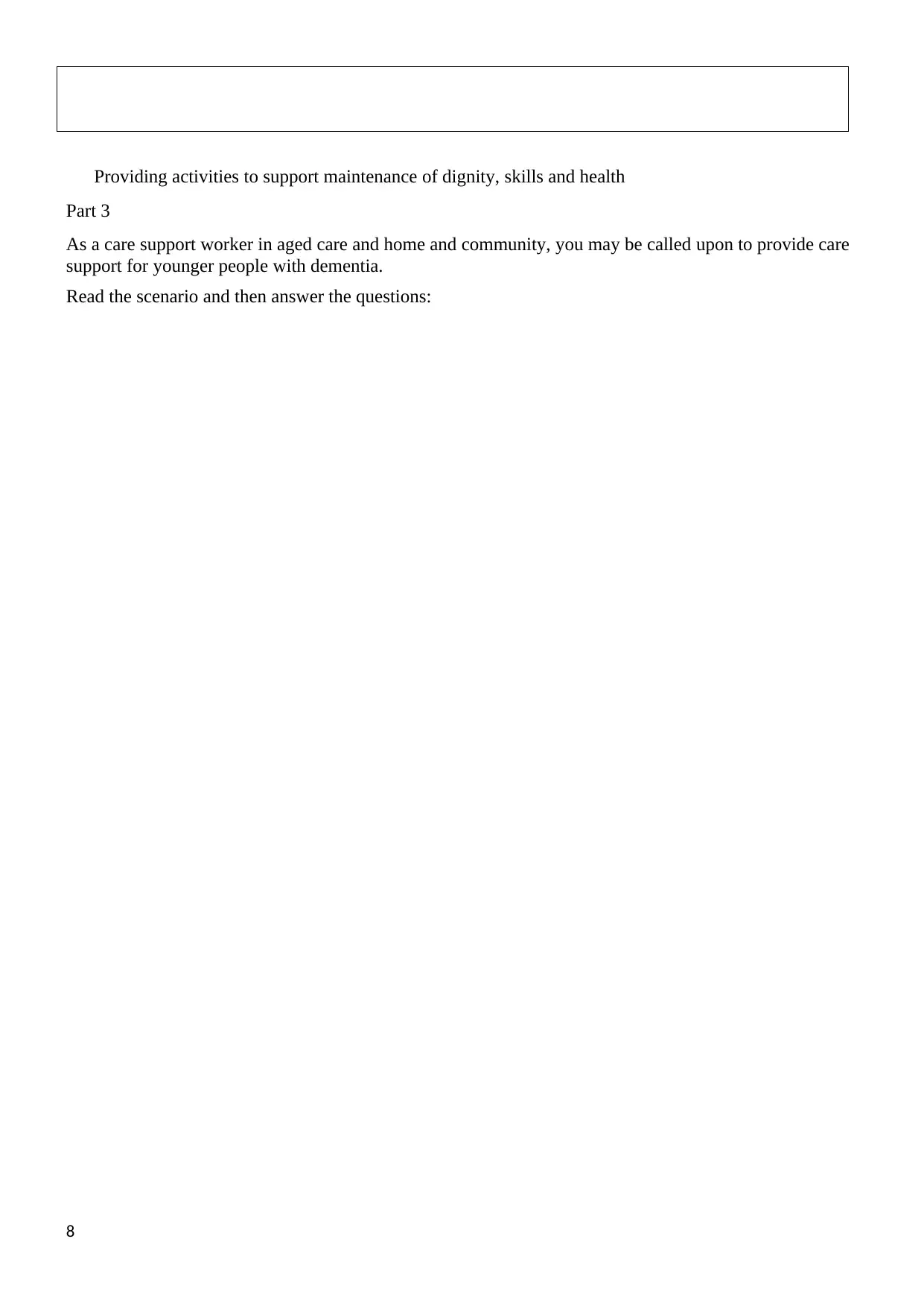
Providing activities to support maintenance of dignity, skills and health
Part 3
As a care support worker in aged care and home and community, you may be called upon to provide care
support for younger people with dementia.
Read the scenario and then answer the questions:
8
Part 3
As a care support worker in aged care and home and community, you may be called upon to provide care
support for younger people with dementia.
Read the scenario and then answer the questions:
8
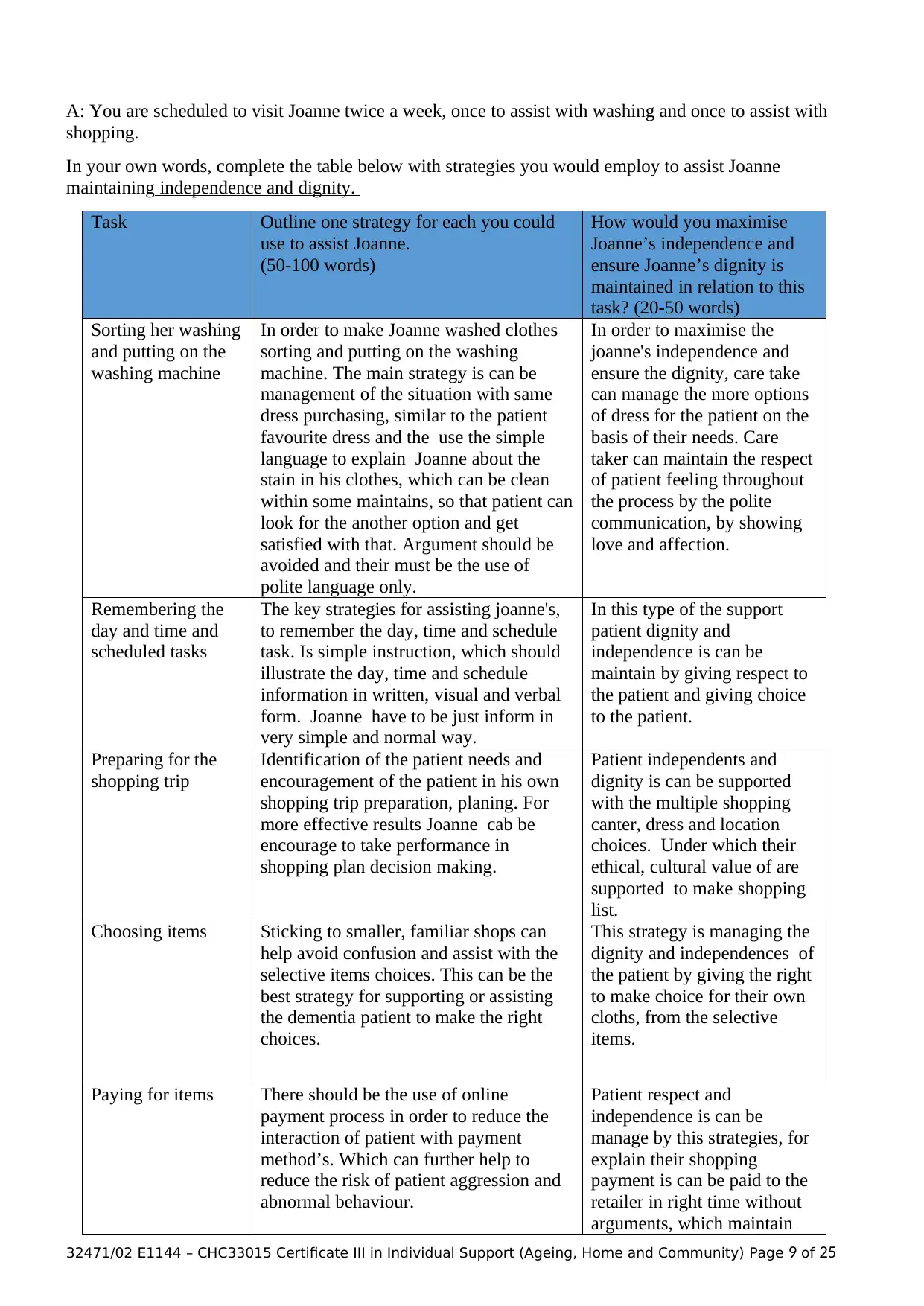
A: You are scheduled to visit Joanne twice a week, once to assist with washing and once to assist with
shopping.
In your own words, complete the table below with strategies you would employ to assist Joanne
maintaining independence and dignity.
Task Outline one strategy for each you could
use to assist Joanne.
(50-100 words)
How would you maximise
Joanne’s independence and
ensure Joanne’s dignity is
maintained in relation to this
task? (20-50 words)
Sorting her washing
and putting on the
washing machine
In order to make Joanne washed clothes
sorting and putting on the washing
machine. The main strategy is can be
management of the situation with same
dress purchasing, similar to the patient
favourite dress and the use the simple
language to explain Joanne about the
stain in his clothes, which can be clean
within some maintains, so that patient can
look for the another option and get
satisfied with that. Argument should be
avoided and their must be the use of
polite language only.
In order to maximise the
joanne's independence and
ensure the dignity, care take
can manage the more options
of dress for the patient on the
basis of their needs. Care
taker can maintain the respect
of patient feeling throughout
the process by the polite
communication, by showing
love and affection.
Remembering the
day and time and
scheduled tasks
The key strategies for assisting joanne's,
to remember the day, time and schedule
task. Is simple instruction, which should
illustrate the day, time and schedule
information in written, visual and verbal
form. Joanne have to be just inform in
very simple and normal way.
In this type of the support
patient dignity and
independence is can be
maintain by giving respect to
the patient and giving choice
to the patient.
Preparing for the
shopping trip
Identification of the patient needs and
encouragement of the patient in his own
shopping trip preparation, planing. For
more effective results Joanne cab be
encourage to take performance in
shopping plan decision making.
Patient independents and
dignity is can be supported
with the multiple shopping
canter, dress and location
choices. Under which their
ethical, cultural value of are
supported to make shopping
list.
Choosing items Sticking to smaller, familiar shops can
help avoid confusion and assist with the
selective items choices. This can be the
best strategy for supporting or assisting
the dementia patient to make the right
choices.
This strategy is managing the
dignity and independences of
the patient by giving the right
to make choice for their own
cloths, from the selective
items.
Paying for items There should be the use of online
payment process in order to reduce the
interaction of patient with payment
method’s. Which can further help to
reduce the risk of patient aggression and
abnormal behaviour.
Patient respect and
independence is can be
manage by this strategies, for
explain their shopping
payment is can be paid to the
retailer in right time without
arguments, which maintain
32471/02 E1144 – CHC33015 Certificate III in Individual Support (Ageing, Home and Community) Page 9 of 25
shopping.
In your own words, complete the table below with strategies you would employ to assist Joanne
maintaining independence and dignity.
Task Outline one strategy for each you could
use to assist Joanne.
(50-100 words)
How would you maximise
Joanne’s independence and
ensure Joanne’s dignity is
maintained in relation to this
task? (20-50 words)
Sorting her washing
and putting on the
washing machine
In order to make Joanne washed clothes
sorting and putting on the washing
machine. The main strategy is can be
management of the situation with same
dress purchasing, similar to the patient
favourite dress and the use the simple
language to explain Joanne about the
stain in his clothes, which can be clean
within some maintains, so that patient can
look for the another option and get
satisfied with that. Argument should be
avoided and their must be the use of
polite language only.
In order to maximise the
joanne's independence and
ensure the dignity, care take
can manage the more options
of dress for the patient on the
basis of their needs. Care
taker can maintain the respect
of patient feeling throughout
the process by the polite
communication, by showing
love and affection.
Remembering the
day and time and
scheduled tasks
The key strategies for assisting joanne's,
to remember the day, time and schedule
task. Is simple instruction, which should
illustrate the day, time and schedule
information in written, visual and verbal
form. Joanne have to be just inform in
very simple and normal way.
In this type of the support
patient dignity and
independence is can be
maintain by giving respect to
the patient and giving choice
to the patient.
Preparing for the
shopping trip
Identification of the patient needs and
encouragement of the patient in his own
shopping trip preparation, planing. For
more effective results Joanne cab be
encourage to take performance in
shopping plan decision making.
Patient independents and
dignity is can be supported
with the multiple shopping
canter, dress and location
choices. Under which their
ethical, cultural value of are
supported to make shopping
list.
Choosing items Sticking to smaller, familiar shops can
help avoid confusion and assist with the
selective items choices. This can be the
best strategy for supporting or assisting
the dementia patient to make the right
choices.
This strategy is managing the
dignity and independences of
the patient by giving the right
to make choice for their own
cloths, from the selective
items.
Paying for items There should be the use of online
payment process in order to reduce the
interaction of patient with payment
method’s. Which can further help to
reduce the risk of patient aggression and
abnormal behaviour.
Patient respect and
independence is can be
manage by this strategies, for
explain their shopping
payment is can be paid to the
retailer in right time without
arguments, which maintain
32471/02 E1144 – CHC33015 Certificate III in Individual Support (Ageing, Home and Community) Page 9 of 25
⊘ This is a preview!⊘
Do you want full access?
Subscribe today to unlock all pages.

Trusted by 1+ million students worldwide
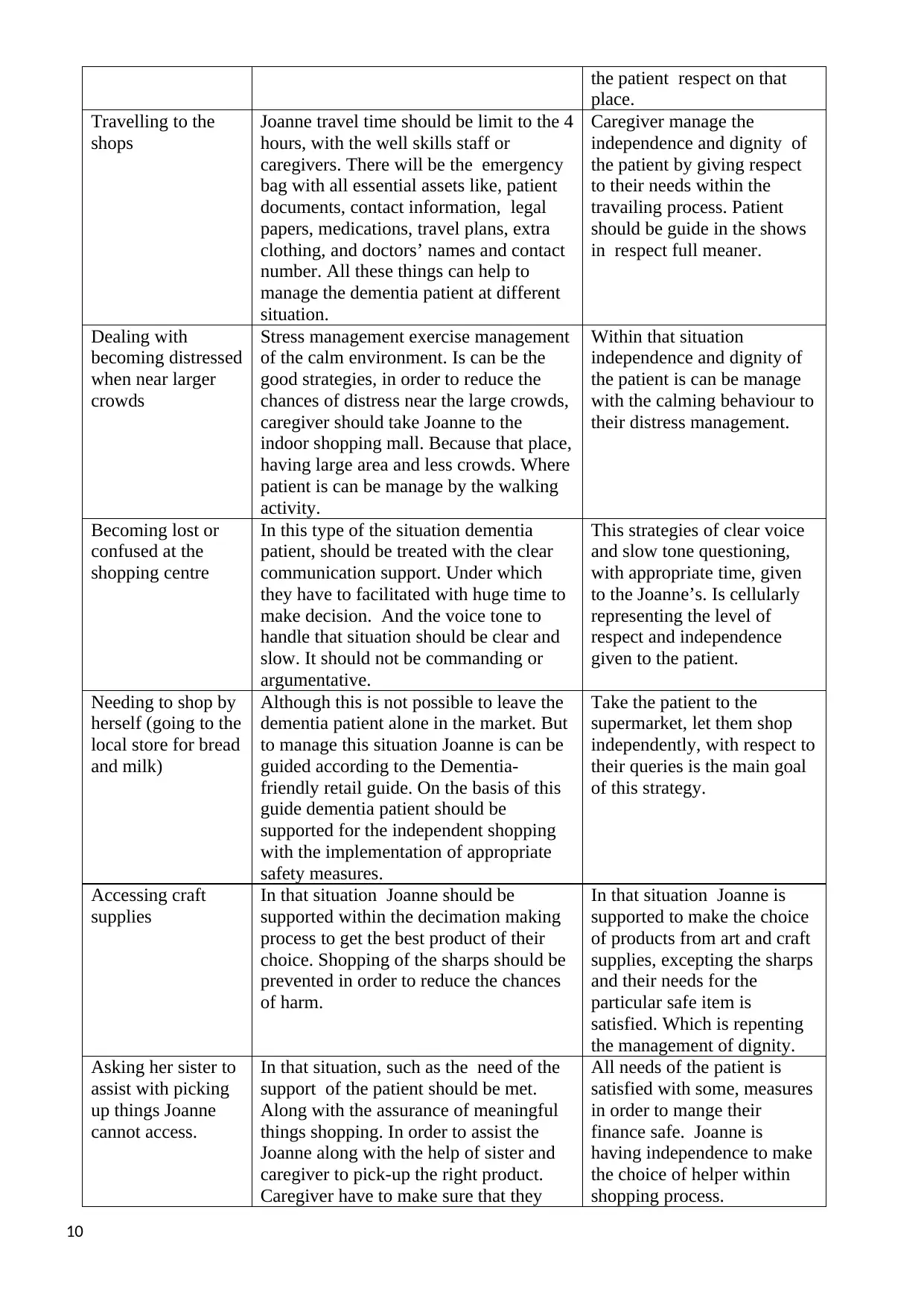
the patient respect on that
place.
Travelling to the
shops
Joanne travel time should be limit to the 4
hours, with the well skills staff or
caregivers. There will be the emergency
bag with all essential assets like, patient
documents, contact information, legal
papers, medications, travel plans, extra
clothing, and doctors’ names and contact
number. All these things can help to
manage the dementia patient at different
situation.
Caregiver manage the
independence and dignity of
the patient by giving respect
to their needs within the
travailing process. Patient
should be guide in the shows
in respect full meaner.
Dealing with
becoming distressed
when near larger
crowds
Stress management exercise management
of the calm environment. Is can be the
good strategies, in order to reduce the
chances of distress near the large crowds,
caregiver should take Joanne to the
indoor shopping mall. Because that place,
having large area and less crowds. Where
patient is can be manage by the walking
activity.
Within that situation
independence and dignity of
the patient is can be manage
with the calming behaviour to
their distress management.
Becoming lost or
confused at the
shopping centre
In this type of the situation dementia
patient, should be treated with the clear
communication support. Under which
they have to facilitated with huge time to
make decision. And the voice tone to
handle that situation should be clear and
slow. It should not be commanding or
argumentative.
This strategies of clear voice
and slow tone questioning,
with appropriate time, given
to the Joanne’s. Is cellularly
representing the level of
respect and independence
given to the patient.
Needing to shop by
herself (going to the
local store for bread
and milk)
Although this is not possible to leave the
dementia patient alone in the market. But
to manage this situation Joanne is can be
guided according to the Dementia-
friendly retail guide. On the basis of this
guide dementia patient should be
supported for the independent shopping
with the implementation of appropriate
safety measures.
Take the patient to the
supermarket, let them shop
independently, with respect to
their queries is the main goal
of this strategy.
Accessing craft
supplies
In that situation Joanne should be
supported within the decimation making
process to get the best product of their
choice. Shopping of the sharps should be
prevented in order to reduce the chances
of harm.
In that situation Joanne is
supported to make the choice
of products from art and craft
supplies, excepting the sharps
and their needs for the
particular safe item is
satisfied. Which is repenting
the management of dignity.
Asking her sister to
assist with picking
up things Joanne
cannot access.
In that situation, such as the need of the
support of the patient should be met.
Along with the assurance of meaningful
things shopping. In order to assist the
Joanne along with the help of sister and
caregiver to pick-up the right product.
Caregiver have to make sure that they
All needs of the patient is
satisfied with some, measures
in order to mange their
finance safe. Joanne is
having independence to make
the choice of helper within
shopping process.
10
place.
Travelling to the
shops
Joanne travel time should be limit to the 4
hours, with the well skills staff or
caregivers. There will be the emergency
bag with all essential assets like, patient
documents, contact information, legal
papers, medications, travel plans, extra
clothing, and doctors’ names and contact
number. All these things can help to
manage the dementia patient at different
situation.
Caregiver manage the
independence and dignity of
the patient by giving respect
to their needs within the
travailing process. Patient
should be guide in the shows
in respect full meaner.
Dealing with
becoming distressed
when near larger
crowds
Stress management exercise management
of the calm environment. Is can be the
good strategies, in order to reduce the
chances of distress near the large crowds,
caregiver should take Joanne to the
indoor shopping mall. Because that place,
having large area and less crowds. Where
patient is can be manage by the walking
activity.
Within that situation
independence and dignity of
the patient is can be manage
with the calming behaviour to
their distress management.
Becoming lost or
confused at the
shopping centre
In this type of the situation dementia
patient, should be treated with the clear
communication support. Under which
they have to facilitated with huge time to
make decision. And the voice tone to
handle that situation should be clear and
slow. It should not be commanding or
argumentative.
This strategies of clear voice
and slow tone questioning,
with appropriate time, given
to the Joanne’s. Is cellularly
representing the level of
respect and independence
given to the patient.
Needing to shop by
herself (going to the
local store for bread
and milk)
Although this is not possible to leave the
dementia patient alone in the market. But
to manage this situation Joanne is can be
guided according to the Dementia-
friendly retail guide. On the basis of this
guide dementia patient should be
supported for the independent shopping
with the implementation of appropriate
safety measures.
Take the patient to the
supermarket, let them shop
independently, with respect to
their queries is the main goal
of this strategy.
Accessing craft
supplies
In that situation Joanne should be
supported within the decimation making
process to get the best product of their
choice. Shopping of the sharps should be
prevented in order to reduce the chances
of harm.
In that situation Joanne is
supported to make the choice
of products from art and craft
supplies, excepting the sharps
and their needs for the
particular safe item is
satisfied. Which is repenting
the management of dignity.
Asking her sister to
assist with picking
up things Joanne
cannot access.
In that situation, such as the need of the
support of the patient should be met.
Along with the assurance of meaningful
things shopping. In order to assist the
Joanne along with the help of sister and
caregiver to pick-up the right product.
Caregiver have to make sure that they
All needs of the patient is
satisfied with some, measures
in order to mange their
finance safe. Joanne is
having independence to make
the choice of helper within
shopping process.
10
Paraphrase This Document
Need a fresh take? Get an instant paraphrase of this document with our AI Paraphraser
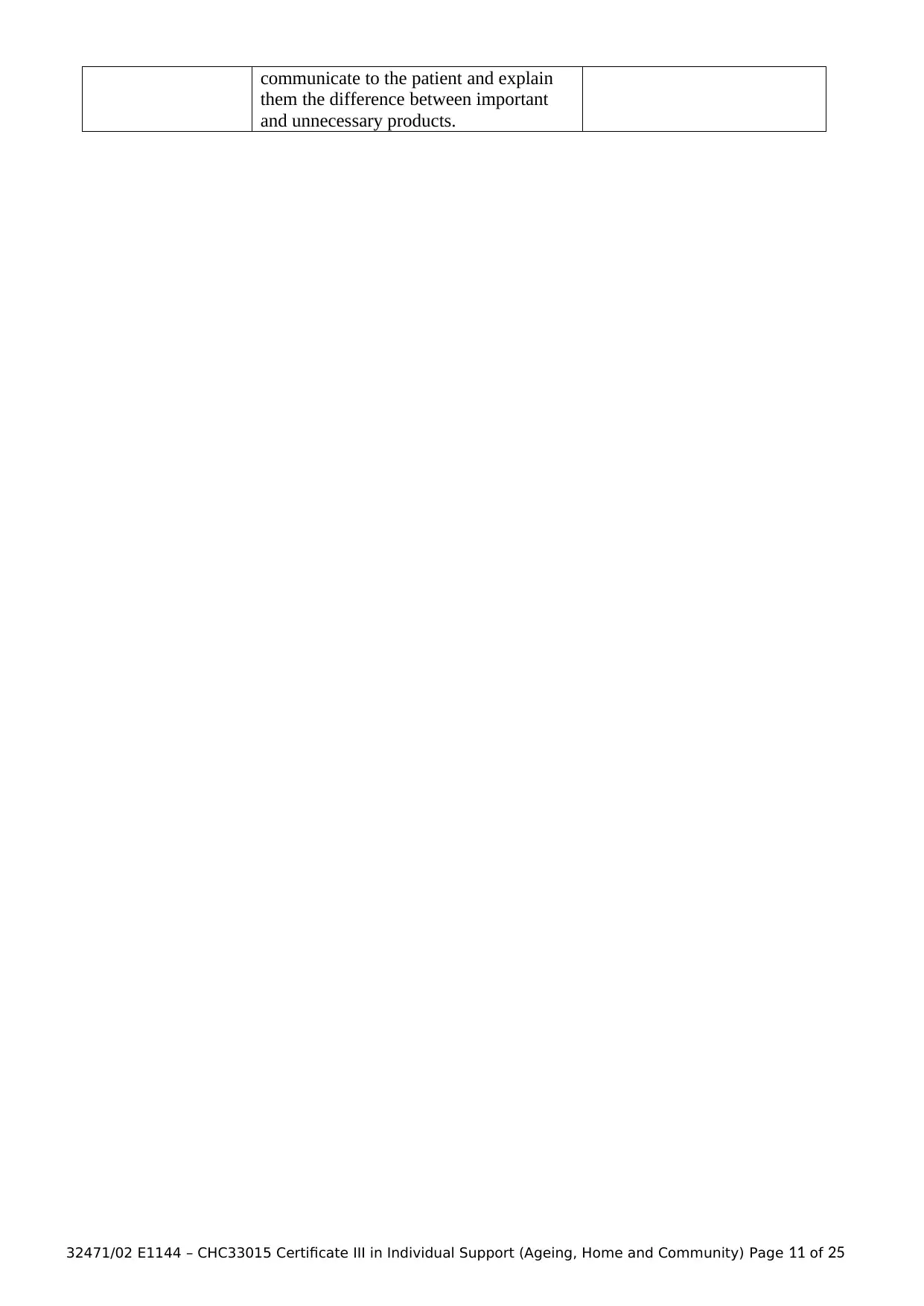
communicate to the patient and explain
them the difference between important
and unnecessary products.
32471/02 E1144 – CHC33015 Certificate III in Individual Support (Ageing, Home and Community) Page 11 of 25
them the difference between important
and unnecessary products.
32471/02 E1144 – CHC33015 Certificate III in Individual Support (Ageing, Home and Community) Page 11 of 25

B: Joanne tells you on one of your trips to the shops that she is worried about her finances. She says that
her brother John comes around and takes money from her purse and she thinks that he knows her account
PIN number. She says that the rental agency wrote her a letter saying she is behind in her rent but she is
confused about this as it gets taken from her account automatically. Outline the steps you would take after
Joanne tells you this information. Explain why you would take these steps. (50-100 words)
In context to this information, which is given by the Joanne, about unauthorised transaction, first step
should be the making the complaint against the misuse of card details. Because this is illustrated by the
RBI that unauthorised withdrawn amount will be returned to the bank account within in 10 days. Then
the new debit card form should be submitted to the bake along with the application of old debit card
block request.
12
her brother John comes around and takes money from her purse and she thinks that he knows her account
PIN number. She says that the rental agency wrote her a letter saying she is behind in her rent but she is
confused about this as it gets taken from her account automatically. Outline the steps you would take after
Joanne tells you this information. Explain why you would take these steps. (50-100 words)
In context to this information, which is given by the Joanne, about unauthorised transaction, first step
should be the making the complaint against the misuse of card details. Because this is illustrated by the
RBI that unauthorised withdrawn amount will be returned to the bank account within in 10 days. Then
the new debit card form should be submitted to the bake along with the application of old debit card
block request.
12
⊘ This is a preview!⊘
Do you want full access?
Subscribe today to unlock all pages.

Trusted by 1+ million students worldwide
1 out of 25
Related Documents
Your All-in-One AI-Powered Toolkit for Academic Success.
+13062052269
info@desklib.com
Available 24*7 on WhatsApp / Email
![[object Object]](/_next/static/media/star-bottom.7253800d.svg)
Unlock your academic potential
Copyright © 2020–2025 A2Z Services. All Rights Reserved. Developed and managed by ZUCOL.





